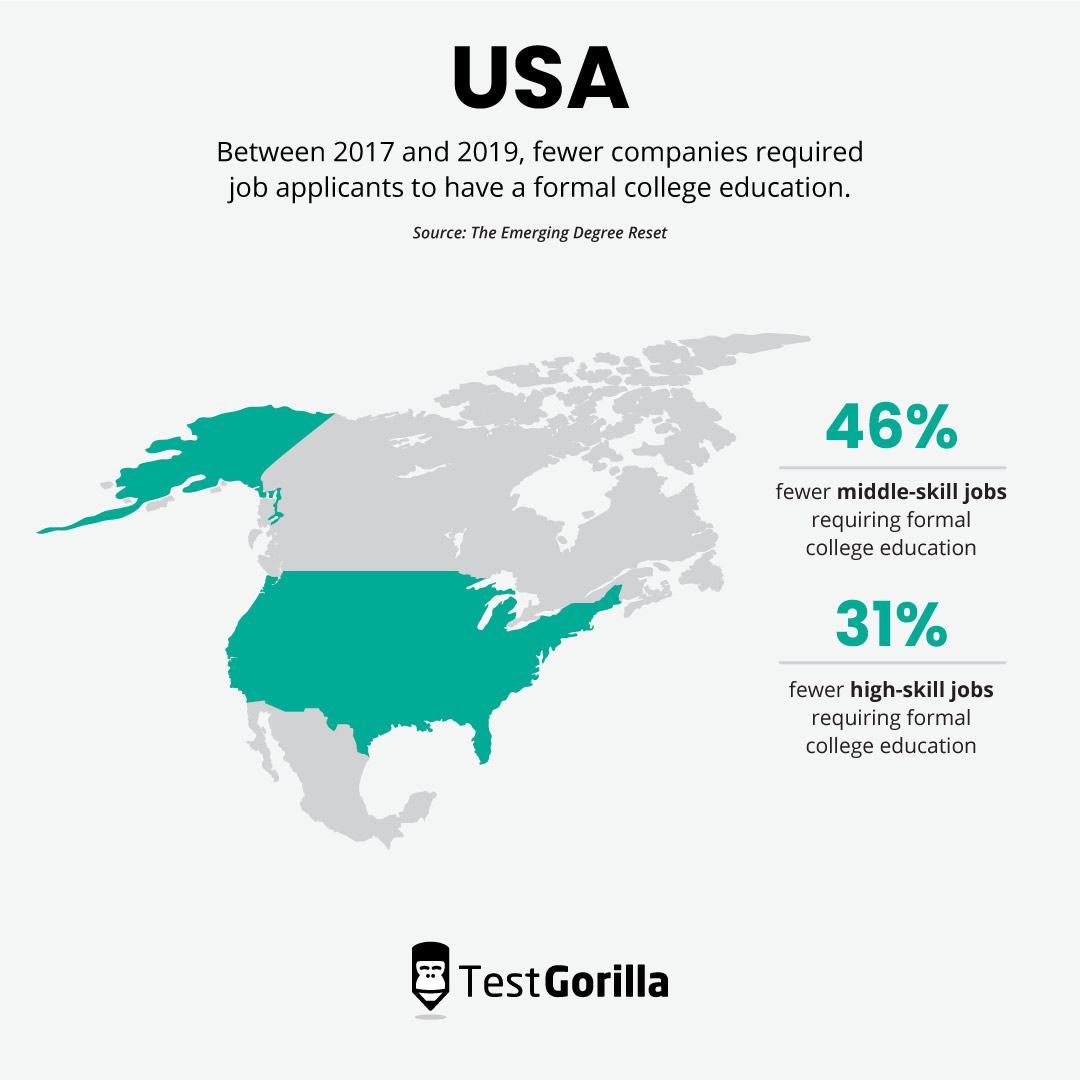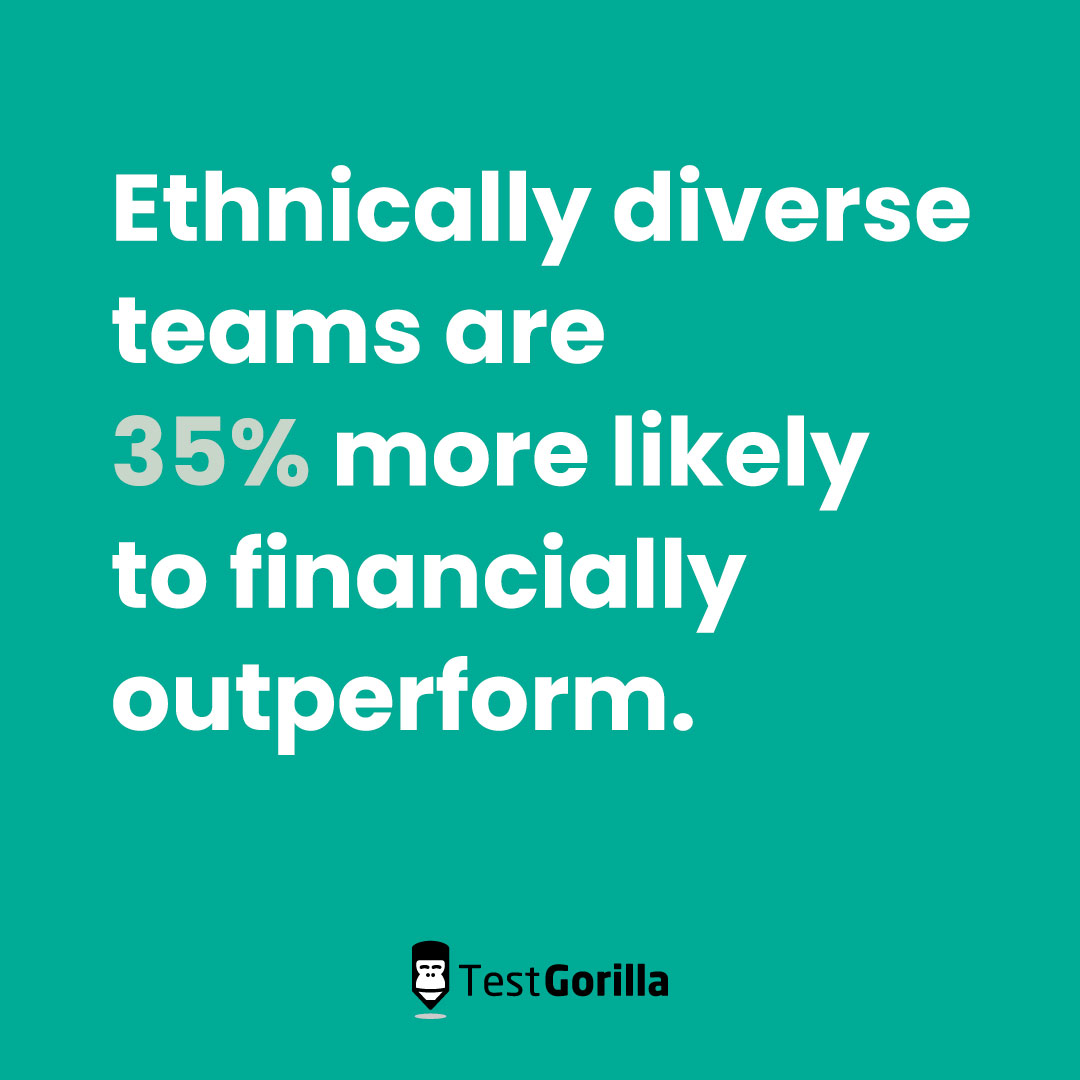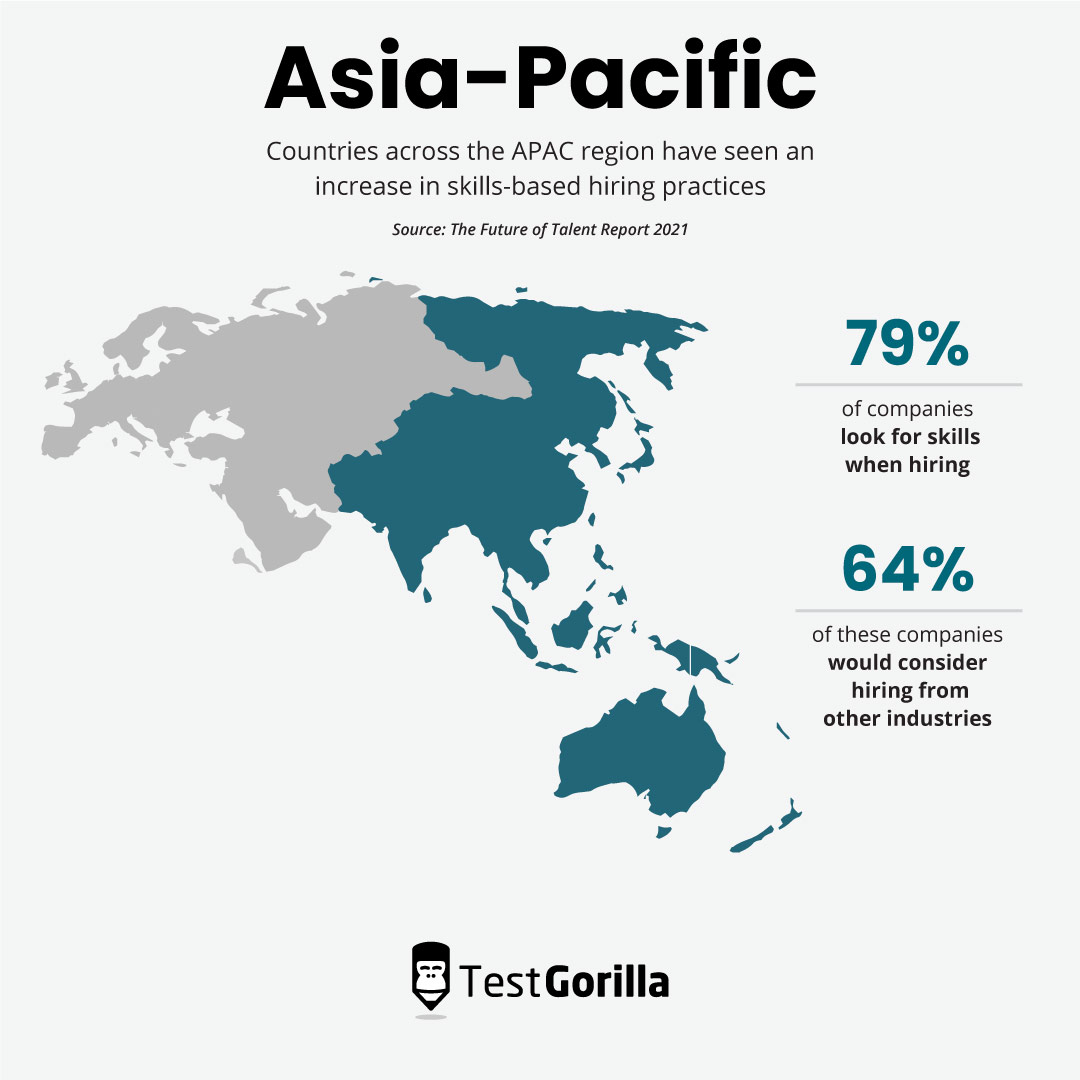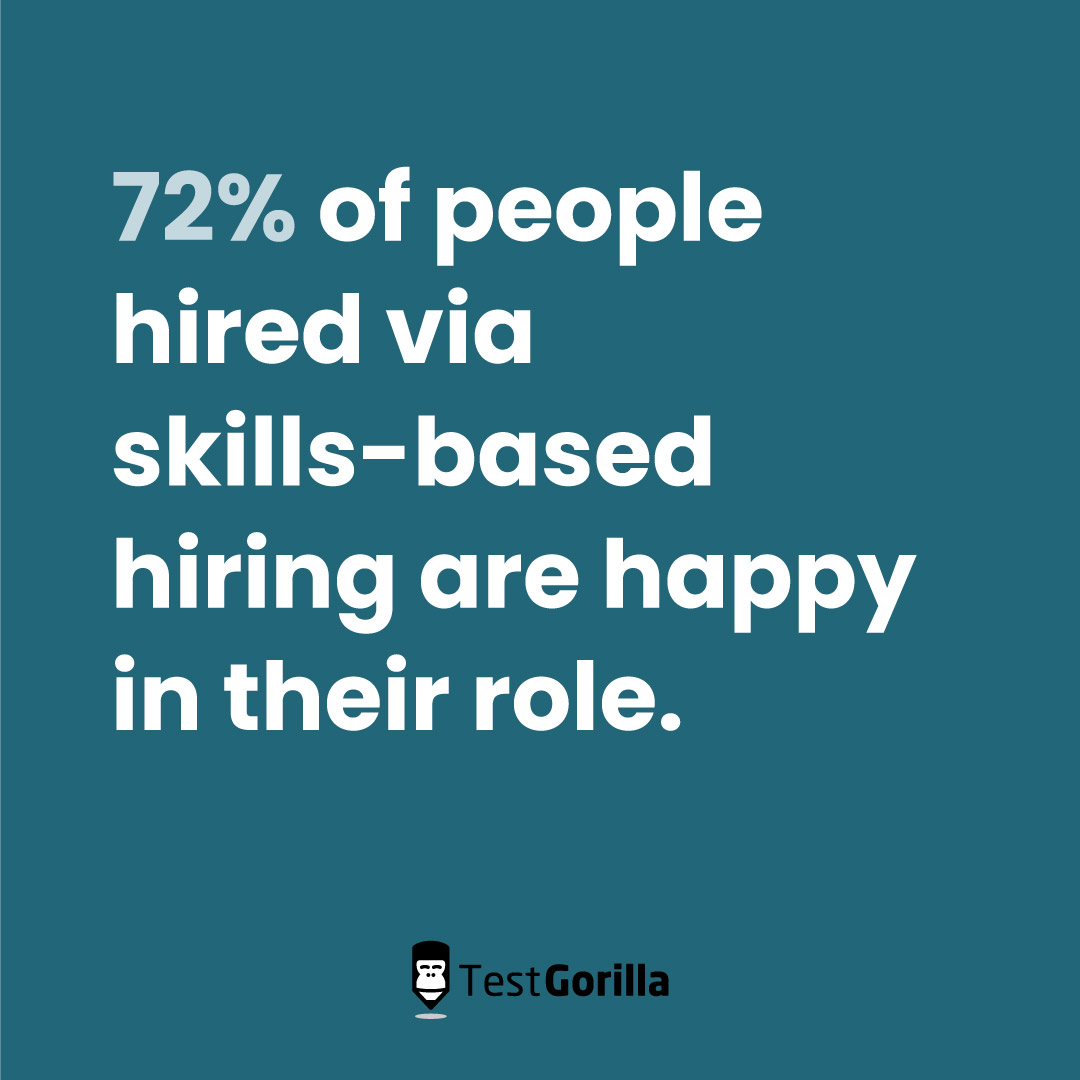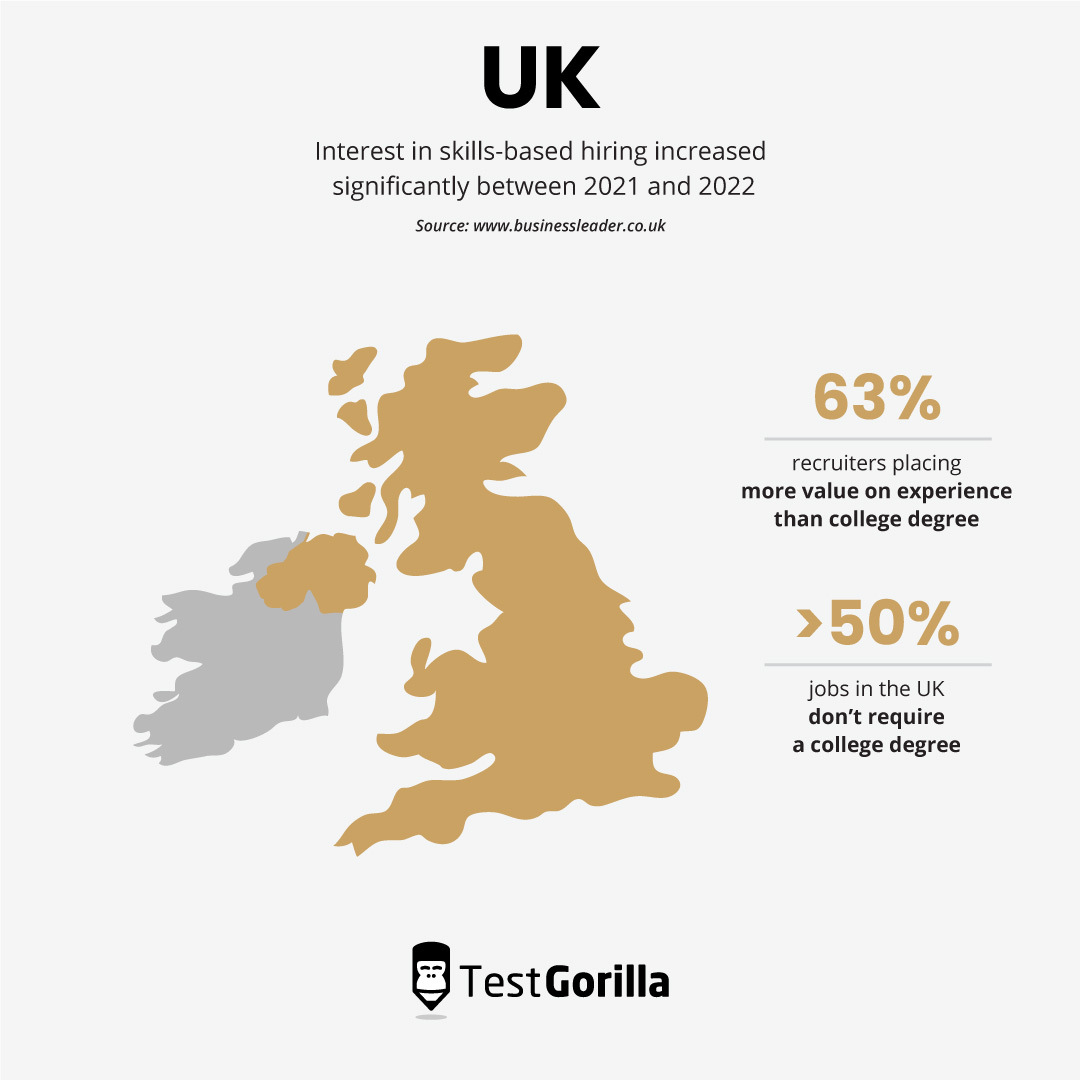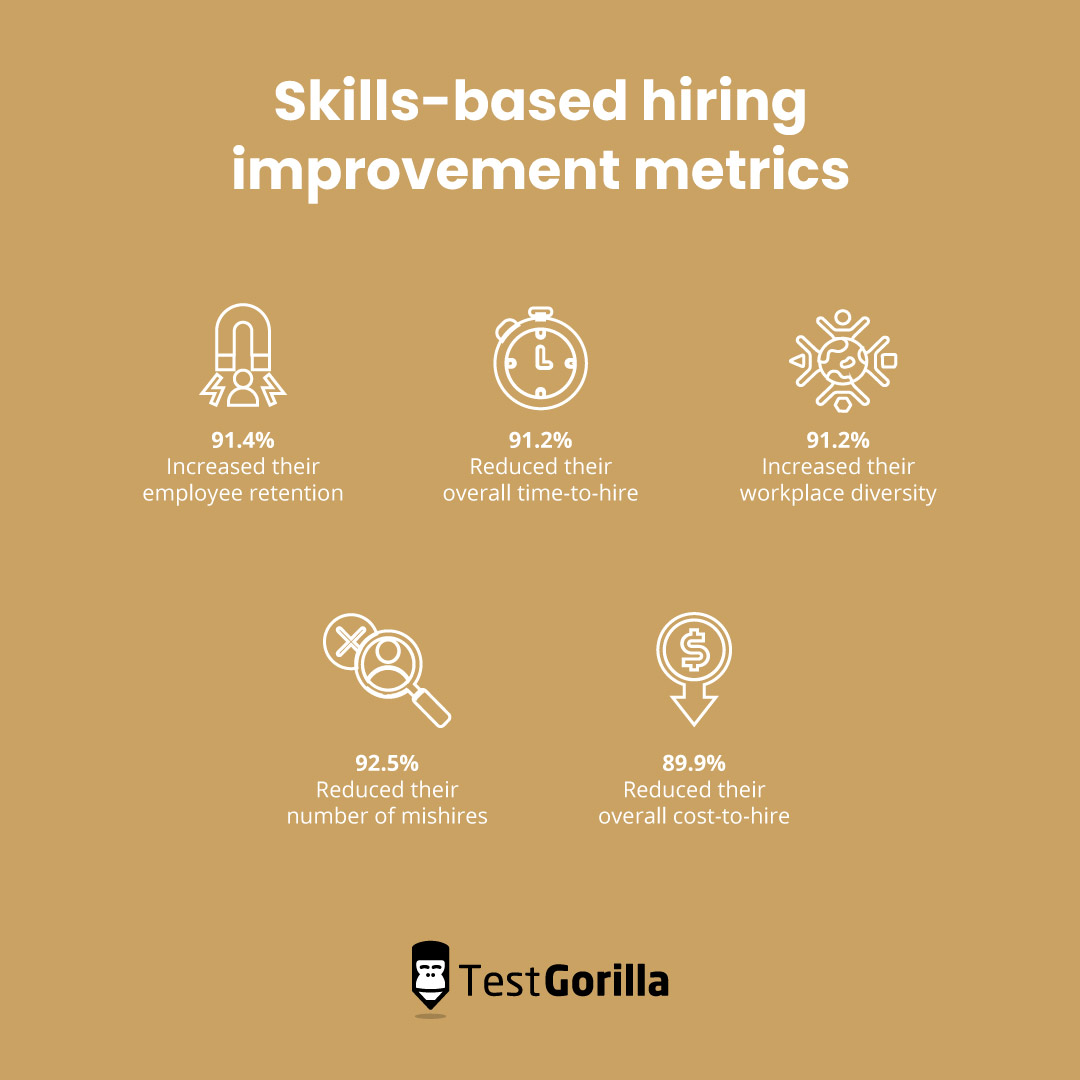Skills-based hiring around the world: Who’s leading the charge?
If you aren’t doing it yet, that’s ok: 58% of companies we surveyed only just adopted skills-based hiring in the past two years.
But from the United States to Singapore, a skills-based approach is quickly becoming a popular way for recruiters to attract and retain global talent.
The reasons for using skills-based hiring vary from region to region. In some parts of the world, organizations use it to streamline high-volume hiring. While in others, the focus is on making teams more diverse and equitable.
Let’s take a closer look at how skills-based hiring works in the USA, UK, and the Asia-Pacific region. We’ll compare the reasons for implementing the practice—and the results of doing so. We’ll also highlight what these examples can teach us about creating a more diverse and higher-performing workforce.
Table of contents
Skills-based hiring trends around the world
Skills-based hiring is a recruitment and hiring approach in which candidates are evaluated based on quantifiable skills rather than subjective factors like resumes.
Among the best practices to hire diverse workforces, skills-based hiring is at the top of the list. And in a number of countries and regions, like the UK and Asia-Pacific (APAC) region, this alternative practice is gaining traction and slowly but surely replacing the outdated resume-based approach to hiring.
We looked at MEDCs (most economically-developed countries) as well as BEM (big emerging market) countries to compile a case study of skills-based hiring in the USA, APAC region, and UK. By comparing countries with different economic makeups, we’ve found varied reasons for implementing the practice, as well as unique challenges and benefits.
USA
Let’s start by looking at the USA, where skills-based hiring is becoming more popular in both the private and public sectors.
A brief history of labor equality in the US
When President Franklin D. Roosevelt passed the Fair Labor Standards Act of 1938, the US saw a much-needed shift towards fairer employment, working conditions, and hiring practices. The bill established a minimum wage, legitimized the 40-hour workweek, and introduced overtime pay.
This first step was essential in creating more equal and just employment opportunities, but the bill fell short of protecting women, people of color, and Black and Indigenous workers.
These protections didn’t come into place until the Equal Pay Act of 1963, which prevented wage discrimination based on gender, and Title VII of the Civil Rights Act of 1964, which prohibited employment discrimination on the basis of race, color, religion, sex, or national origin.
But even when discrimination became illegal, unconscious bias often crept into traditional recruitment practices. This meant that hiring managers would overlook well-qualified candidates if they came from a background other than their own. And unfortunately, this situation continues today.
Skills-based hiring on a company, state, and federal basis
Now, over half a century later, skills-based hiring is gaining headway. The approach is helping to put into practice the protections that those bills promised to safeguard but, in reality, often fell short of doing.
Between 2017 and 2019, 46% of middle-skill and 31% of high-skill jobs saw an important reset in requirements, meaning fewer companies required job applicants to have a formal college education.
And numerous high-profile companies, including Accenture, IBM, Google, and EY, have dropped degree requirements for certain positions and moved towards a skills-based hiring approach to fill these roles.
Skills-based hiring isn’t just happening on a company-by-company basis—it’s receiving government attention as well:
The Advancing Skills-Based Hiring Act, proposed by Representative Elise Stefanik of New York, aims to support employers who want to adopt skills-based hiring practices.
The State of Maryland recently eliminated the requirement of a four-year degree for thousands of state jobs.
In May 2022, the US Office of Personnel Management (OPM) published guidelines for applying a skills-based approach to federal hiring practices.
How skills-based hiring is impacting the US job market
The shift towards a skills-based method and a move away from the traditional degree-requirement approach could open up over a million jobs to workers without a college degree in the coming five years.
Almost two-thirds of adults in the US don’t have a university education, and as a result of systematic inequalities, fewer Black and Hispanic individuals hold college degrees than their white and Asian counterparts. Adopting skills-based hiring can therefore open doors to people who have historically been much more limited in their employment choices.
On top of this, ethnically-diverse teams are 35% more likely to financially outperform, meaning that skills-based hiring isn’t just good for society in the US—it’s good for businesses and the economy as a whole.
Asia-Pacific
Due to high-volume hiring and an increased emphasis on skills training, skills-based hiring is ramping up across the Asia-Pacific as well. Let’s look at how this practice is growing across the region.
Hiring for skills across the APAC region
Countries across the APAC region have seen an increase in skills-based hiring practices that come as both a necessity and part of a broader shift towards more equal hiring practices.
This shift is highlighted in The Future of Talent Report 2021, which surveyed over 3,500 respondents across Australia, China, India, Japan, Malaysia, Singapore, and the Philippines.
The study found that 79% of companies now look for skills when hiring, vs. 21% that prioritize experience and education. And 64% of these organizations said they’d consider hiring candidates from other industries, as long as their skills were transferable.
Diversity was a priority for 61% of the companies surveyed. So skills-based hiring serves as a springboard for creating more equal opportunities and forming teams that thrive thanks to the unique backgrounds, experiences, and abilities of their employees.
In countries with large populations, like India and China, skills-based hiring has made it possible to effectively conduct high-volume hiring and streamline the recruitment process.
82% of APAC companies surveyed used data to help them make hiring decisions. Using technology like skills-based testing, enables hiring managers to rank candidates accurately based on their knowledge and competencies rather than intuit their capabilities through resumes.
Initiatives to help candidates develop their skills (and find jobs they love) in Singapore and India
Individual countries in the APAC region have taken their own measures towards making skills-based hiring the norm. For example, In Malaysia, the Skills for Prosperity Program aims to improve the employability and earning potential of workers.
By working with government, employers’ and workers’ organizations and other stakeholders, the program addresses the technical skills shortages among the Malaysian working population. The result is a more resilient and adaptable workforce.
In India, where 50% of recruiters use skills as a key factor when searching for candidates, skills-based hiring is also on the rise.
As a result, some Indian states are taking measures to train their populations and make them more employable. Take, for example, the creation of more than 60 skills development institutes in the state of Rajasthan, as well as the Karnataka government’s allocation of resources towards specialized skills development programs.
This is good news for workers in the APAC Region, because when companies match employees’ skills with job positions rather than focusing on degrees, candidates are generally more satisfied with their roles. Our findings show that 72.1% of people hired via skills-based hiring are happy in their roles.
UK
With a shortage of over 300,000 workers in the UK as a result of Brexit, employers need new approaches, like skills-based hiring, to fill vacant positions. The practice is becoming more popular among UK organizations and it brings widespread benefits.
Ditching the resume
Many UK industries have high levels of discriminatory hiring practices. We see this in the construction industry, where there are few women and people of color in the workforce. And this persists in the business world, where women make up less than a third of high-level leadership positions among FTSE 350 companies.
Thankfully, skills-based hiring is creating new opportunities and promoting the creation of more diverse teams. Recent research found that interest in skills-based hiring increased by 63% between 2021 and 2022 and that recruiters now place more value on experience than a college degree.
The analysis of over 100,000 jobs across over a dozen sectors also found that there were more jobs available in the UK that didn’t require a college degree than did. However, the average salary for workers with a higher education degree in those positions was generally greater than what people in the same roles who didn’t have a degree earned.
How skills-based hiring is creating more diverse workplaces (and improving business performance)
Moving towards a skills-based (rather than resume-based) approach is having a positive impact on diversity efforts. A study of 27 industries between 2017 and 2022 recorded a 65% increase in the number of women hired for graduate roles when hiring managers used skills-based hiring.
Similarly, the number of women hired into senior-level positions jumped by 70% when companies focused on skills rather than resumes.
Seeing more women in these roles is good news for UK companies, as gender-diverse teams are 25% more likely to have better financial performance than homogenous teams.
Plus, skills-based hiring is good for business: The TestGorilla State of Skills-Based Hiring 2022 report found that 92.5% of organizations using skills-based hiring saw a reduction in mis-hires, 89.8% reported a reduction in hiring costs, and 91.2% saw higher employee retention rates.
What drives skills-based hiring in different parts of the world?
The reasons for skills-based hiring implementation vary between different regions:
In the United States, it relates to a widespread move towards diversity, equity, and inclusion (DE&I) practices.
In India and much of the APAC region, we see a necessity for using skilled-based hiring due to large populations and high-volume recruitment. And given the region’s push for promoting skills development rather than traditional education, it just makes sense to place more importance on skills rather than degrees.
Skills-based hiring in the UK is gaining traction and has gained significant popularity in recent years. Due to both a labor shortage and a push towards DE&I policies, it’s becoming more and more common among UK employers.
Each region certainly faces its own challenges in implementing skills-based hiring, ranging from getting buy-in from internal stakeholders to not having the proper HR tech solutions to make skills-based hiring possible.
What can we learn from regional varieties of skills-based hiring
Skills-based hiring isn’t just for multinational corporations in the world’s most economically developed countries: You’ll find hiring managers in different corners of the world implementing the approach.
Motives for adopting skills-based hiring vary. But the results are the same: more equal opportunities for candidates and a more diverse, higher-performing workforce.
So whatever your reason for considering skills-based hiring, take these examples from around the globe as inspiration for implementing it in your own organization. It’s better for business, for your team, and for society as a whole.
Discover why you need to stay on top of global trends and embrace skills-based hiring in your recruitment practices. Download the State of Skills-based Hiring 2022 report to learn more.
Related posts
You've scrolled this far
Why not try TestGorilla for free, and see what happens when you put skills first.
Latest posts
The best insights on HR and recruitment, delivered to your inbox.
Biweekly updates. No spam. Unsubscribe any time.

Skills tests to hire the best
Our screening tests identify the best candidates and make your hiring decisions faster, easier, and bias-free.
Free resources
A step-by-step blueprint that will help you maximize the benefits of skills-based hiring from faster time-to-hire to improved employee retention.
With our onboarding email templates, you'll reduce first-day jitters, boost confidence, and create a seamless experience for your new hires.
This handbook provides actionable insights, use cases, data, and tools to help you implement skills-based hiring for optimal success
A comprehensive guide packed with detailed strategies, timelines, and best practices — to help you build a seamless onboarding plan.
This in-depth guide includes tools, metrics, and a step-by-step plan for tracking and boosting your recruitment ROI.
Get all the essentials of HR in one place! This cheat sheet covers KPIs, roles, talent acquisition, compliance, performance management, and more to boost your HR expertise.
Onboarding employees can be a challenge. This checklist provides detailed best practices broken down by days, weeks, and months after joining.
Track all the critical calculations that contribute to your recruitment process and find out how to optimize them with this cheat sheet.

